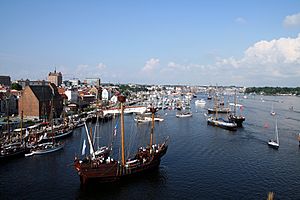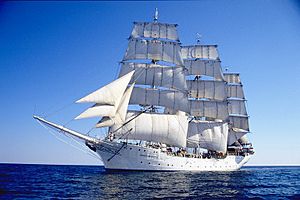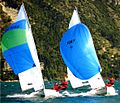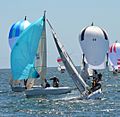Sailing facts for kids


Sailing is all about using the wind to move a boat across water. For a long time, sailing boats were super important for moving cargo (goods) and people around the world. But by the end of the 19th century, boats powered by steam started to take over. Today, sailing is mostly a fun hobby or a sport. However, in some parts of the world, sailing boats are still very important for daily life. Many military groups also use sailing vessels to train their sailors.
Sailing is also an exciting sport! It's even one of the sports you can see at the Olympic Games.
Contents
The History of Sailing
Sailing has a long and interesting past. Humans have been using sails for thousands of years. Early sailors used simple sails to explore new lands and trade goods.
Ancient Sailing Vessels
Long ago, people used sailing boats to travel across oceans. For example, the Fijian people used special outrigger boats with unique crab claw sails. These boats helped them explore the Pacific Ocean.
Famous Sailing Ships
One of the most famous sailing ships was the Santa María. This was the ship Christopher Columbus used when he sailed to America. Later, in the 1800s, fast ships called clippers became popular. They were built for speed and carried goods like tea and wool very quickly across the seas.
Sailing Today
While steam and motorboats replaced many sailing ships, sailing is still very much alive. People enjoy it for fun, for racing, and sometimes for long journeys.
How Sailing Works
Sailing might look like magic, but it's all about understanding the wind and how it pushes or pulls the sails.
Understanding the Wind
Sailors need to know where the wind is coming from. They use the wind to move their boat in different directions. This is called knowing the "points of sail."
Sailing Against the Wind
You can't sail directly into the wind. Instead, sailors zig-zag, or "tack," to move forward. This means they sail a little bit into the wind, then turn and sail the other way.
Sailing with the Wind
When the wind is coming from behind the boat, sailors can let their sails out wide. This helps the wind push the boat forward.
Parts of a Sailboat
A sailboat has many parts that help it move. The main parts are the hull (the body of the boat), the mast (the tall pole), and the sails.
Different Types of Sails
There are many kinds of sails. Some sails are shaped like wings and help the boat go fast, even against the wind. Other sails, like spinnakers, are big and balloon-like. They are used when the wind is coming from behind to catch as much air as possible.
Sailing as a Sport
Sailing is a popular competitive sport around the world. Races can be short and fast, or long journeys across oceans.
Olympic Sailing
Sailing has been part of the Olympic Games for a long time. Athletes compete in different types of boats, showing off their skills and speed.
Types of Sailing Boats
There are many kinds of boats used for sailing. Some are small and fast, like dinghies or skiffs. Others are large yachts, like Comanche, which race across oceans.
Images for kids
-
Fijian voyaging outrigger boat with a crab claw sail
-
Replica of Christopher Columbus's carrack, Santa María under sail
-
A late-19th-century American clipper ship
-
Cruising sailing yacht at anchor in Duck Harbor on Isle au Haut, Maine
-
Comanche leaving Newport, Rhode Island for Plymouth, England in the 2015 Rolex Transatlantic Race
-
Points of sail (and predominant sail force component for a displacement sailboat). A. Luffing (no propulsive force) — 0-30° B. Close-hauled (lift)— 30–50° C. Beam reach (lift)— 90° D. Broad reach (lift–drag)— ~135° E. Running (drag)— 180° True wind (VT) is the same everywhere in the diagram, whereas boat velocity (VB) and apparent wind (VA) vary with point of sail.
-
The ocean currents
-
Spinnakers are adapted for sailing off the wind.
-
Aerodynamic force components for two points of sail. Left-hand boat: Down wind with detached airflow like a parachute— predominant drag component propels the boat with little heeling moment. Right-hand boat: Up wind (close-hauled) with attached airflow like a wing—predominant lift component both propels the boat and contributes to heel.
See also
 In Spanish: Navegación a vela para niños
In Spanish: Navegación a vela para niños

























